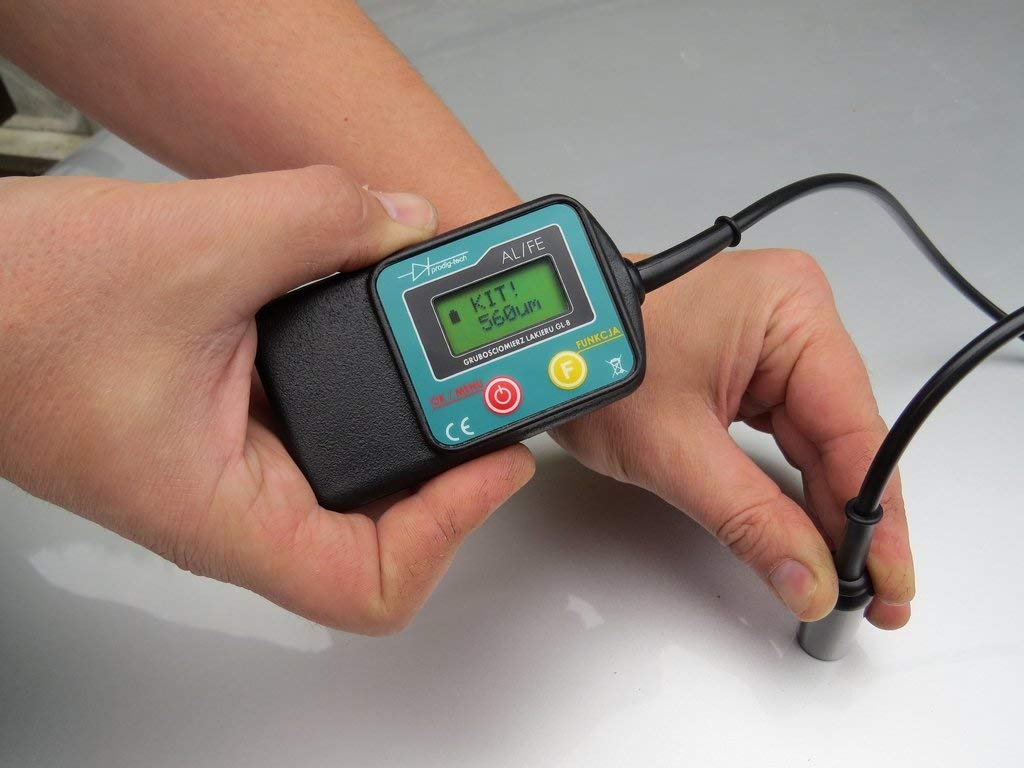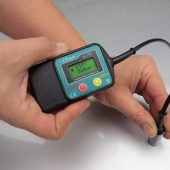There are two ways to measure paint thickness: the traditional destructive method and newer non-destructive methods.
Non-destructive measurement is the standard today in most industries and applications because it’s quick and easy, highly accurate and doesn’t damage the paint surface.
Why Measure Paint Thickness?

There are many reasons for measuring the thickness of a paint coating including quality control, inspection, and maintenance.
Measuring paint thickness ensures a surface such as the exterior of a car or a tool has the right coat thickness and that the paint is spread evenly.
In maintenance, the thickness of a paint coating can indicate whether there is significant wear. This is important for things like bridges, ships and cranes.
Technicians can also measure paint thickness to detect repairs done on a surface, or check whether repairs have been done properly.
A paint thickness gauge is not just for industrial use.
If you are buying a used car, you can measure the thickness of paint on different panels to detect unreported repair work. Areas with thicker paint are often a sign of a repair that’s been painted over.
Tools for Measuring Paint Thickness
Paint thickness is measured using a paint thickness gauge. There are two primary types of paint thickness gauges: destructive and non destructive.
Destructive paint thickness gauges strip paint from the surface and make a V-groove. Then you measure the thickness of the cross section left behind using a built-in microscope or magnifier.
You can see an example of a destructive gauge in use in the video below.
In most applications, non-destructive paint thickness gauges are the best since they can accurately measure the thickness of a coating without damaging it. There’s also less risk of human errors messing up with the measurements.
There are several types of non-destructive gauges.
Permanent Magnet Gauge
This is the simplest and cheapest type of paint thickness gauge. It uses a magnet attached to a spring. How much tension it takes to pull the magnet away from the surface determines paint thickness.
Permanent magnet gauges, sometimes called mechanical gauges, have an analogue scale that displays the approximate thickness of the coating.
Because they are non-electric, permanent magnet gauges are useful where electric equipment is not allowed or would be dangerous such as in a flammable environment.
Though cheap, permanent magnet paint thickness gauges have the lowest accuracy thus are mostly used by consumers, mostly people shopping for a used car. It’s a great tool for detecting body damage and repair work.
Another limitation of a permanent magnet gauge is that it’s useful only on magnetic surfaces. It won’t work on plastic, fiberglass, wood, aluminium or any non-magnetic surface.
Electromagnetic Induction Gauge
If you want more accuracy, you’ll need an electromagnetic induction gauge. It detects the thickness of non-magnetic paints on magnetic surfaces.
The gauge has three coils. One coil generates a magnetic field and the other two coils detect changes in the magnetic field.
The difference in magnetic field detected by the two coils is used to calculate distance to the substrate below the paint, and thus the thickness of the paint.
The main limitation of this method is that it only works on magnetic surfaces.
Eddy Currents Gauge
If you are measuring coating thickness on a non-magnetic metal like aluminium, an eddy currents paint thickness gauge is the best choice.
The gauge contains a coil that generates eddy currents in the metal substrate. A probe then measures the strength and nature of the magnetic fields resulting from these eddy currents. From this, the gauge can calculate how thick the pain coating is.
The main limitation of an eddy currents gauge is that it works only on metal surfaces. That’s because the surface needs to be conductive for eddy currents to form.
An eddy current paint thickness gauge will not work on fiberglass, plastic, glass, or wood.
Note: Most modern paint thickness gauges have a 2-in-1 design. You get the option to use electromagnetic induction or eddy currents in the same tool.
Ultrasonic Gauge
An ultrasonic paint thickness gauge is one of the most expensive tools for measuring paint thickness. It’s also the most versatile type of gauge, able to measure coating thickness on just about any kind of surface.
That’s because it uses sound to measure how thick a coating is. It can work on glass, wood, metal, plastic, and other materials.
Another big advantage of an ultrasonic gauge is its ability to detect multiple paint layers and measure their individual thickness.
Are Paint Thickness Gauges Accurate?
The accuracy of a paint thickness gauge depends on the type of gauge, build quality, and your skill in using it.
Generally, the more you pay for a paint thickness gauge, the more accurate it’s going to be. Most gauges come with the level of accuracy indicated.
A paint thickness gauge with higher resolution, meaning it can measure smaller changes in thickness, is also going to be more accurate and is suitable for sensitive applications with low tolerance for errors.
Make sure you follow the provided instructions when using the gauge including observing environmental requirements such as temperature and humidity. Some gauges may be less accurate when used in very cold or very hot environments, or on surfaces that are colder or hotter than the probe can handle.
The condition of the surface to be measured will also affect accuracy. Corrosion, dirt, or moisture on the surface can make the gauge less accurate.
Prepare the surface as per the manual’s instructions.
How To Calibrate A Paint Thickness Gauge?
Paint thickness gauges used in professional and industrial environments need to be calibrated regularly to ensure accurate measurements.
Some paint thickness gauges come with films or foils with which you can calibrate the gauge. Such gauges will often have automatic calibration.
You can also calibrate the gauge using a surface with a known coating thickness. The difference between the known thickness and the reading on the gauge will tell you how accurate the gauge is.
You can then adjust the gauge yourself to make it accurate, or send it to the manufacturer for re-calibration.


